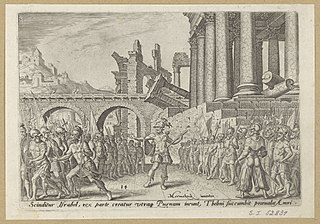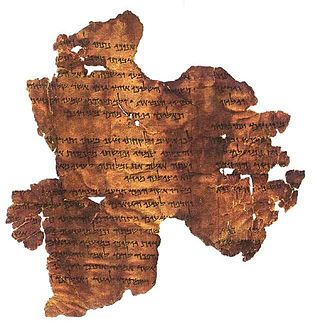The Book of Kings is a book in the Hebrew Bible, found as two books in the Old Testament of the Christian Bible. It concludes the Deuteronomistic history, a history of Israel also including the books of Joshua, Judges and Samuel.

Jeroboam I was, according to the Hebrew Bible, the first king of the northern Kingdom of Israel following a revolt of the ten tribes against Rehoboam that put an end to the United Monarchy.

Baasha was, according to the Hebrew Bible, the third king of the northern Israelite Kingdom of Israel. He was the son of Ahijah of the Tribe of Issachar. Baasha's story is told in 1 Kings 15:16–16:7.

Tibni was a claimant to the throne of Israel and the son of Ginath. Albright has dated his reign to 876–871 BC, while Thiele offers the dates 885–880 BC.

Nadab was, according to the Hebrew Bible, the second king of the northern Israelite Kingdom of Israel. He was the son and successor of Jeroboam.
The House of Gadi was a dynasty of kings of the Northern Kingdom of Israel. The dynasty is also called the House of Menahem, after its founder. The dynasty lasted for only twelve years and ruled from Israel's then-capital of Samaria. The dynasty is so named because Menahem was the son of Gadi.

Ahijah the Shilonite was a Levite prophet of Shiloh in the days of Solomon, as mentioned in the Hebrew Bible's First Books of Kings. Ahijah foretold to Jeroboam that he would become king.

Jehu son of Hanani was a prophet mentioned in the Hebrew Bible, who was active during the 9th century BC.

Zimri, was the fifth king of Israel. His reign lasted only seven days. William F. Albright has dated his reign to 876 BCE, while E. R. Thiele offers the date 885 BCE. His story is told in 1 Kings, Chapter 16.
Gibbethon or Gibbeton was a city in the land of Canaan which, according to the record in the Hebrew Bible, was occupied by the Tribe of Dan after the entry of the Israelites into the Promised Land and was then given to the Tribe of Levi, and which some identify as "Tel Malot", located northwest of the city of Beit Shemesh and due west of the city of Gezer. According to the Book of Joshua, it was given as a Levitical city to the Kohathites.

Hosea 1 is the first chapter of the Book of Hosea in the Hebrew Bible or the Old Testament of the Christian Bible. This book contains the prophecies attributed to the prophet Hosea son of Beeri, and this chapter especially sets forth the spiritual whoredom of Israel by symbolical acts. It is a part of the Book of the Twelve Minor Prophets.

According to the First Book of Kings and the Second Book of Chronicles of the Hebrew Bible, Jeroboam's Revolt was an armed insurrection against Rehoboam, king of the United Monarchy of Israel, and subsequently the Kingdom of Judah, led by Jeroboam in the late 10th century BCE. The conflict, referring to the independence of the Kingdom of Samaria and the subsequent civil war during Jeroboam's rule, is said to have begun shortly after the death of Solomon lasting until the Battle of Mount Zemaraim. The conflict began due to discontent under the rule of Solomon's successor, his son Rehoboam, and was waged with the goal of breaking away from the United Monarchy of Israel. Though this goal was achieved very early on in the conflict, the war continued throughout the duration of Rehoboam's reign and well into the reign of his son, Abijam, who defeated the armies of Jeroboam but failed to reunite the kingdoms.
The House of Baasha or Baasha dynasty was a reigning dynasty of the Kingdom of Israel. They are depicted in the first of the Books of Kings. Their estimated reign is placed in the 10th century BCE.
The House of Zimri or the Zimri dynasty was a short-lived reigning dynasty of the Kingdom of Israel. It is depicted in the first of the Books of Kings, where it represents a transitional period between the reigns House of Baasha and the Omrides.
The House of Jehu or Jehu dynasty was a reigning dynasty of the Kingdom of Israel. They are depicted in both of the Books of Kings. Their estimated reign is placed from the 9th century to the 8th century BCE.

1 Kings 12 is the twelfth chapter of the Books of Kings in the Hebrew Bible or the First Book of Kings in the Old Testament of the Christian Bible. The book is a compilation of various annals recording the acts of the kings of Israel and Judah by a Deuteronomic compiler in the seventh century BCE, with a supplement added in the sixth century BCE. 1 Kings 12:1 to 16:14 documents the consolidation of the kingdoms of northern Israel and Judah: this chapter focusses on the reigns of Rehoboam and Jeroboam.

1 Kings 14 is the fourteenth chapter of the Books of Kings in the Hebrew Bible or the First Book of Kings in the Old Testament of the Christian Bible. The book is a compilation of various annals recording the acts of the kings of Israel and Judah by a Deuteronomic compiler in the seventh century BCE, with a supplement added in the sixth century BCE. 1 Kings 12:1 to 16:14 documents the consolidation of the kingdoms of northern Israel and Judah: this chapter focusses on the reigns of Jeroboam and Nadab in the northern kingdom and Rehoboam in the southern kingdom.

1 Kings 15 is the fifteenth chapter of the Books of Kings in the Hebrew Bible or the First Book of Kings in the Old Testament of the Christian Bible. The book is a compilation of various annals recording the acts of the kings of Israel and Judah by a Deuteronomic compiler in the seventh century BCE, with a supplement added in the sixth century BCE. 1 Kings 12:1-16:14 documents the consolidation of the kingdoms of northern Israel and Judah. This chapter focusses on the reigns of Abijam and Asa in the southern kingdom, as well as Nadab and Baasha in the northern kingdom.

1 Kings 16 is the sixteenth chapter of the Books of Kings in the Hebrew Bible or the First Book of Kings in the Old Testament of the Christian Bible. The book is a compilation of various annals recording the acts of the kings of Israel and Judah by a Deuteronomic compiler in the seventh century BCE, with a supplement added in the sixth century BCE. 1 Kings 12:1-16:14 documents the consolidation of the kingdoms of northern Israel and Judah. This chapter focusses on the reigns of Baasha, Elah, Zimri, Omri and Ahab in the northern kingdom during the reign of Asa in the southern kingdom.











